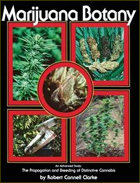
by Robert Connell Clarke
Storage
Cannabis floral clusters are best stored in a cool, dark place. Refrigeration will retard the breakdown of cannabinoids, but freezing has adverse effects. Freezing forces moisture to the surface from the inside of the floral tissues and this may harm the resins secreted on the surface. Floral clusters with the shade leaves intact are well protected from abrasion and accidental removal of resins, but manicured floral clusters are best tightly packed so they do not rub together. Glass jars and plastic freezer bags are the most common containers for the storage of floral clusters. Polyethylene plastic sandwich or trash bags are not suited to long-term storage since they breathe air and water vapor. This may cause the floral clusters to dry out excessively and lose potency. Heat-sealed boilable plastic pouches do not breathe and are frequently used for storage. Glass canning jars are also very air-tight, but glass breaks.
It is feared by some connoisseurs that plastic may also impart an unpleasant taste to the floral clusters. In either case, additional care is usually taken to protect the floral clusters from light so another opaque container is used to cover the clear glass or plastic wrapping. Clusters are not sealed permanently until they have finished curing. Curing involves the presence of oxygen, and sealing floral clusters will end the free exchange of oxygen and end curing. However, oxygen also causes the slow breakdown of THC to CBN, so after the curing process is completed, the container is completely sealed. Any oxygen present in the container will be used up and no more can enter. Nitrogen has been suggested as a packing medium because it is very nonreactive and inexpensive. Jars or bags may be flooded with nitrogen to displace air and then sealed. Vacuum-sealing machines are available for Mason jars and may be modified to vacuum-sealed bags.
The proper harvesting, curing, and storage of Cannabis closes the season and completes’ the life cycle. Cannabis is certainly a plant of great economic potential and scientific interest; its rich genetic diversity deserves preservation and its possible beneficial uses deserve more research.

